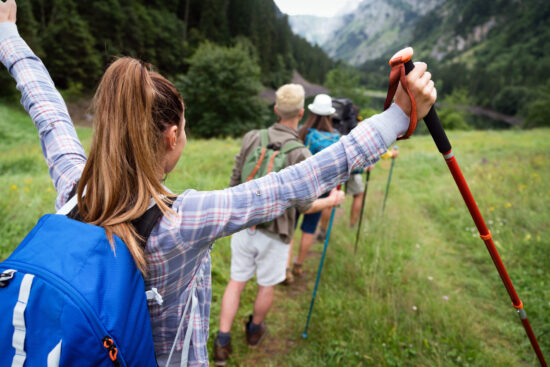
Whether you’re a seasoned outdoorsperson or just going out on a quick hike, you’ve probably seen people hiking with walking sticks (aka trekking poles). The question is, are trekking poles worth it?
Benefits of Walking Sticks
From professional-grade poles to perfectly-sized branches you find along the way, trekking poles can add stability and comfort to your walk. They are particularly beneficial for those experiencing balance or mobility challenges, as they provide a sturdy support system.
They can serve as a safeguard against potential injuries, provide much-needed support during the recovery phase, and can help you regain your mobility gradually.
Walking sticks help you:
- Work your arms. Every day is Leg Day when hitting the trails, but are your arms getting some exercise too? Trekking poles not only keep your arms engaged but keep your hands from swelling up as you’re climbing by keeping them elevated.
- Maintain your balance. The only thing better than two legs is four legs! Poles act as another set of limbs to give you stability when navigating tricky terrain. They can significantly reduce the risk of falls and accidents as they provide added traction when walking on sand and gravel.
- Alleviate pressure on joints & muscles. Thanks to their weight distribution and load-bearing capabilities, walking sticks are useful for nearly everyone.
- Test ice strength and water depth. Many of the worst-case scenarios when hiking involve water and ice. Your walking sticks can be a useful tool to ensure you’re not stepping on thin ice or deep waters.
- Maintain a good pace. Experienced hikers agree that using Trekking Poles is a great way to establish and maintain a rhythm for longer periods of time. Many find the repetitive motion to be meditative and relaxing.
Cons of Walking Sticks
While walking sticks can offer many benefits, there are some potential drawbacks to consider:
- They can be cumbersome. Let’s face it, hauling around two long sticks can be limiting in some situations, particularly if you’re expecting to take lots of pictures, have to use rope assistance, or are navigating crowded spaces.
- Dependency. Some users may become overly reliant on walking sticks, leading to decreased strength and balance over time as the body becomes accustomed to the support.
- Added weight. While many professional-grade Trekking Poles are lightweight and easily storable, cheaper (and nature-made) versions of walking sticks can become quite heavy as you travel longer distances.
- Additional energy spent. As we mentioned above, using walking sticks can add an upper body layer to your hike. This makes the hike more physically demanding and can cause you to spend more calories. For those of us going on extremely long hikes, or with limited access to food, this may not be a good idea.
- Movement patterns. Finally, the use of walking sticks changes your upper body movement pattern. Our regular upper body movement is rotational in nature (think of swing your arms as you walk/run) and walking sticks force the torso into a straight forward pattern. Depending on how walking sticks are used, they can also potentially create uneven weight distribution, leading to strain or discomfort in other parts of the body, such as the shoulders or wrists.
Are Walking Sticks Right For You?
It’s essential to weigh these potential drawbacks against the benefits of using walking sticks, considering your personal needs and preferences.
Walking sticks can be a great aid for a wide range of individuals. Seniors keen on staying active can use them to maintain their pace with ease while hikers and outdoor enthusiasts can use walking sticks for navigating challenging terrains and enjoying their adventures without worrying about stability. This can prove the trekking pole worth it.
Moreover, the newfound confidence that comes with using walking sticks can contribute to a sense of self-reliance and freedom.
Consulting with a healthcare professional or physical therapist can also provide guidance on whether walking sticks are appropriate and how to use them safely and effectively.
Did you know you have Direct Access* to Physical Therapy? No referral, no problem!
So, with all that said…
Let’s lace and up and hit the trails!
Before you head out, make sure to check out our Top 5 hiking spots in the DC Area!
Are injuries or pain holding you back from enjoying the great outdoors? Click here to find a TJC location near you!
Source: The Mayo Clinic
